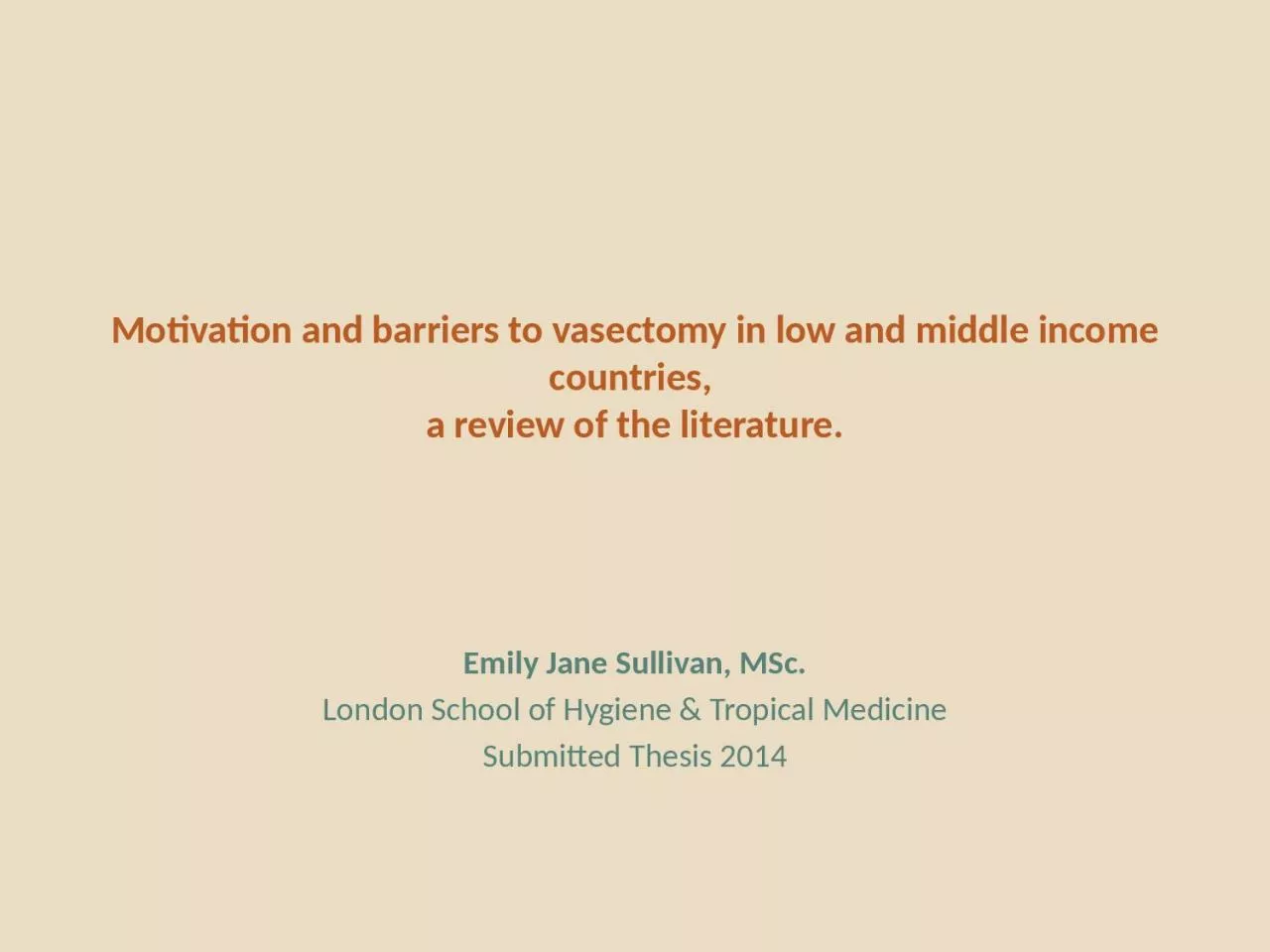

countries a review of the literature Emily Jane Sullivan MSc London School of Hygiene amp Tropical Medicine Submitted Thesis 2014 Did you know Q Most children born to one women ID: 1034720
Download Presentation The PPT/PDF document "Motivation and barriers to vasectomy in ..." is the property of its rightful owner. Permission is granted to download and print the materials on this web site for personal, non-commercial use only, and to display it on your personal computer provided you do not modify the materials and that you retain all copyright notices contained in the materials. By downloading content from our website, you accept the terms of this agreement.
1. Motivation and barriers to vasectomy in low and middle income countries, a review of the literature.Emily Jane Sullivan, MSc.London School of Hygiene & Tropical Medicine Submitted Thesis 2014
2. Did you know?Q: Most children born to one women?A: 69 children by Russian women, Feodor Vassilyev16 pairs of twins, 7 triplets, & 4 quadrupletsQ: Most children fathered by one man?A: 1,042 children by Moroccan Sultan Moulay Ismail4 wives and 500+ partners*LSTHM Lecture September 2014. Photo Credit: Wikipedia
3. Value of Male vs. Female SterilizationPopulation Reference Bureau. Family Planning Worldwide 2013 Datasheet. Washington, DC, USA: Population Reference Bureau, USAID, 2013. Smith GL, Taylor GP, Smith KF. Comparative risks and costs of male and female sterilization. American Journal of Public Health. 1985;75(4):370-4Marie Stopes. What is a couple year of protection? Access: https://mariestopes.org/sites/default/files/MSI-CYP-Infographic.pdf
4. Value of Male vs. Female SterilizationPopulation Reference Bureau. Family Planning Worldwide 2013 Datasheet. Washington, DC, USA: Population Reference Bureau, USAID, 2013.
5. Value of Male vs. Female SterilizationPopulation Reference Bureau. Family Planning Worldwide 2013 Datasheet. Washington, DC, USA: Population Reference Bureau, USAID, 2013.
6. Value of Male vs. Female SterilizationPopulation Reference Bureau. Family Planning Worldwide 2013 Datasheet. Washington, DC, USA: Population Reference Bureau, USAID, 2013.
7. Aim To understand the low prevalence of vasectomy in LMIC:by identifying the profile of vasectomy users or acceptors, including their motivations and barriers.
8. Methods: Inclusion CriteriaType: Primary studies, peer-reviewed or grey literaturePublication date: 1980 to 2014Language: EnglishSetting: LMICFindings: Quantitative, qualitative, and mixed-methodsTopic: Focus on describing acceptors or users of vasectomyAvailability: Full text
9. Methods: Search, Quality, AnalysisSystematic Literature Search: Screen abstracts & full articles: 1,365 studies.Final inclusion: 18 studies.Quality Appraisal: 8 strong, 8 moderate, 2 poor.Data Analysis: Integrated Narrative ApproachQualitative, Quantitative & Mixed studies.
10. Results: Study CharacteristicsStudy Locations: Bangladesh, Costa Rica, Ghana (2), Guatemala, India (4), Iran, Kenya, Mexico, Nepal (2), Nigeria, Philippines, Rwanda, Sri Lanka, Tanzania, Turkey.Study Participants: 12,744 men, 1,322 women, 29 healthcare providers.Study Designs:Qual (8) Quant (6), Mixed Methods (4).
11. Results: Strong Motivations Limit number of children, exceeded desired, multiples Economic Stability Feeling of responsibility InformedDifference between male & femaleMisinformation corrected PH NurseTalk with a sterilized man or coupleSpouse ApprovalAware of man’s other partnersMisinformation CorrectedMan initiate conversation Diagnosis or illness Side effects from other methods (IUDs)Women’s Health Near miss mortality or frequent pregnancy Improve Love LifeConfidently avoid pregnancy with wifeOr with other partnersReligious ViewsOnly have children can care for Education & Services provided at faith- center
12. Results: Strong BarriersConcerned if she gets pregnantSpouse DisapprovesMisinformationMan will seek out other partnersKeep vasectomy a secretCommunity PerceptionLoss on control within familyLoss of authority in communityReligious ViewsHeightened when confused with castrationSimilar to other forms of family planningCan’t remarry if wife changes her mindFuture UncertaintyMaternal or child mortalityImprovedeconomic circumstances Lack of AccessDelayed, have unintended childrenNo designated providerDiscouraged or humiliated by providersMisinformationSide effects & OperationProcedure is castrationLocal languageGeneral poor health, gain or loose weightSexual desire or dysfunction
13. Summary of ResultsFrames sterilized men as: Economically stable, in good health, able to work, and with normal sexual function.Educational resources include: Procedure details;Difference between male and female sterilization;Testimonials from sterilized men or couples; Endorsement statements from faith leaders.
14. Recommendations:Improve access to services:Mobile clinics & accepting providers;Targeted education: Adverse health event or FP side effects;Continually assess motivations and barriers:Vasectomy camp users (not static clinics);Apply nuanced findings to educational materials and counseling.
15. Looking Forward: Global Commitments & Local ActionsCommitment: To not make assumptions. Men may be interested and willing undergo vasectomy. Action: To incorporate thoughtful and ethical vasectomy awareness, education, and services into in all family planning programming.Vasectomy has the potential to alleviate burden from women and healthcare systems.
16. Thank you! Questions? Acknowledgements:Joelle Mak, London School of Hygiene & Tropical Medicine;Susannah Mayhew, PhD, London School of Hygiene & Tropical Medicine;Lynda Clarke, PhD, London School of Hygiene & Tropical Medicine;Johns Hopkins Bloomberg School of Public Health. Emily J. Sullivan, MSc.E-mail: emsully71@gmail.comPhoto Credit: International Conference on Family Planning 2015 website